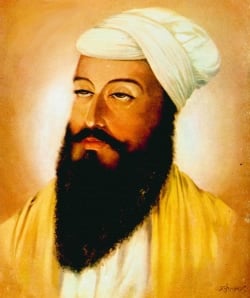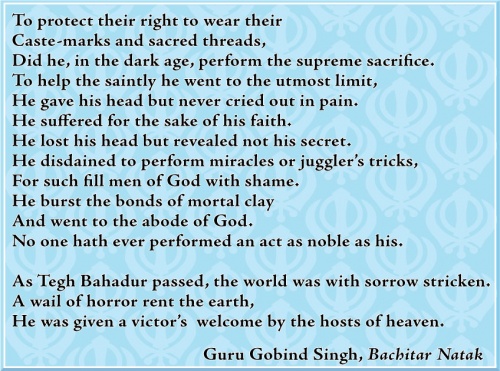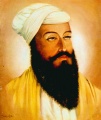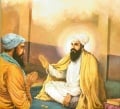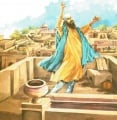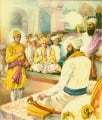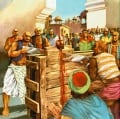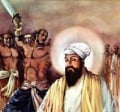Guru Tegh Bahadur
When the Almighty manifests himself in human form, he takes the whole human race in His loving Embrace. This God like warmth of the Divine Incarnate flows out to the whole creation and yearns for universal welfare and redemption. This Nectar of Grace and Love flowed from the Beneficient, All Loving Guru Tegh Bahadur (Guru Nanak - The Ninth) to 500 Pandits of Kashmir and through them to a whole religion, a whole nation.
Sri Guru Tegh Bahadur Sahib's sacrifice for the pandits of Kashmir has to be viewed in this background and context. He, being the Jagat Guru, belongs to all, the whole universe. The love and mercy of a Prophet, a Messiah, a Jagat Guru is impartial, it knows no difference. It showers like rain on all alike. When Pandits of Kashmir, subjected to untold persecution and tyranny, approached Sri Guru Tegh Bahadur Sahib for protection, the most compassionate Guru had shown an unexampled mercy characteristic of the House of Guru Nanak. — Brig. Partap Singh Ji Jaspal (Retd.)
| Guru Tegh Bahadur (1621 to 1675) | |
| Full Name : | Tegh Bahadur |
| Personal Details | |
| Birth : | Wednesday, April 18, 1621 |
| Guruship : | Saturday, 16 April 1664- 8 July, 1675 |
| Joti Jot : | Wednesday, November 24, 1675 at Chandani Chownk New Delhi |
| Family | |
| Parents : | Guru Har Gobind & Mata Nanaki |
| Brother/Sisters : | Brother - Baba Gurditta, Baba Suraj Mal, Baba Ani Rai, Baba Atal Rai Sister - Bibi Biro |
| Spouse : | Mata Gujri |
| Children : | Guru Gobind Singh |
| Other Details | |
| Bani in GGS: | Salok Mahala 9 |
| Other Info: | 115 hymns |
Guru Tegh Bahadur Ji (Gurmukhi: ਗੁਰੂ ਤੇਗ਼ ਬਹਾਦੁਰ) (Wednesday, April 18, 1621 - Wednesday, November 24, 1675), revered by the Sikhs as Srisht-di-Chadar (Protector of humanity), was the ninth of the Ten Gurus of Sikhism. He had become Guru on 16 April, 1664, following the footsteps of his grand-nephew and the eighth Guru, Guru Har Krishan Ji.
A poet, a thinker, and a warrior, Guru Teg Bahadur Ji carried forward the light of sanctity and divinity of Guru Nanak Dev Ji and the subsequent Sikh Gurus. His spiritual writings, detailing varied themes such as, the nature of God, human attachments, body, mind, sorrow, dignity, service, death, and deliverance, are registered in the form of 116 poetic hymns in the sacred scripture, the Sri Guru Granth Sahib Ji. To spread the message of Sikhism, the Guru traveled extensively through the Indian subcontinent, setting up several new preaching centers. He founded the town of Chak-Nanki in Punjab, later enlarged by the tenth Nanak, Guru Gobind Singh Ji, into the city of Sri Anandpur Sahib.
In May 1675, Guru Tegh Bahadur Ji was approached by Hindu Pandits from the Kashmir region, seeking the Guru's intercession against the forced conversions of Hindus to Islam by the Mughal rulers of India. For supporting the Hindu Pandits by resisting these forced conversions, and for himself refusing to convert to Islam, Guru Teg Bahadur Ji was publicly executed via beheading at the imperial capital of Delhi on the orders of Emperor Aurangzeb. Today, Gurdwara Sis Ganj Sahib and Gurdwara Rakab Ganj Sahib stand at the sites of beheading and cremation of Guru Ji’s body. Along with Guru Teg Bahadur Ji, three other Sikhs, Bhai Mati Das, Bhai Sati Das, and Bhai Dyal Das, were also executed.
On Guru Teg Bahadur Ji’s supreme sacrifice to champion fundamental human rights for all, his son, the tenth Nanak, Guru Gobind Singh Ji, wrote:
Thheekar forh dilees sir, Prabh pur keeaa payaan,
Teg Bahadur see kirya, karee na kinahoo aan.
Teg Bahaadur ke chalat, bhayo jagat ko sok,
Hai hai hai sabh jag bhayo, jai jai jai sur lok.
Casting off his bodily vesture on the head of Suzerain Of Delhi; Teg Bahadur departed to the Realm of God.
None who came into the world performed such glorious deeds as him.
On his departure, there was dismay in the world.
This world cried, "Alas, Alas". The Heavens rang with greetings of victory.
(Guru Gobind Singh)
Early life
Guru Ji whose original name was Tyag Mal (Master of Renunciation) spent his childhood at Amritsar. In his early years he learned Gurmukhi, Hindi, Sanskrit and Indian religious philosophy from Bhai Gurdas, and archery and horsemanship from Baba Budha while his father Guru Hargobind Ji, Master of Miri and Piri taught him swordsmanship. Only 13 years old, he asked his father to accompany him into battle as his village was attack by Painde Khan and the Mughals in a battle over Shah Jahan's hawk. During the battle he had weighed into the enemies with abandon, slashing his sword right and left.
After the battle was won, (the Battle of Kartarpur) the victorious Sikhs returning home honored their new hero with a new 'warriors' name. And so Tyag Mal Ji was renamed Tegh Bahadur Ji (lit. Brave sword wielder or Best sword wielder).(Tegh = wielder of the sword. Bahadur (originally meaning brave was by that time being also used as a superlative meaning better or best). The young Tegh Bahadur soon showed a bent in the direction of the earlier Sikhs Gurus who had passed the 'seli' of Nanak (the sacred headgear of renunciation) to each new Guru. He delved into his studies and spent his time in meditation living up to his given name - Master of Renunciation. He was married to Mata Gujri Ji at Kartarpur in 1632.
After the untimely death of his son Bhai Gurditta, Guru Hargobind seemingly started grooming his grandson Har Rai to sit next on Guru Nanak's seat. Har Rai Ji became Guru Hargobind's successor in 1644. Shortly after this Guru Hargobind asked Tegh Bahadur Ji to move with his wife and his mother to the village of Bakala. He had told his wife, who had wanted her son to follow the father as Guru, that one day he would become Guru and have a son and that both would become famous in their fight for justice.
For the next 20 years the Master of Renunciation spent most of his time in an underground room absorbed in meditation. Before Guru Har Krishan Ji passed to God’s court, he indicated that his successor would be found in Bakala. Earlier a wealthy Sikh trader Makhan Shah whose ship was caught in a violent storm prayed to God that if his ship reached port safely he would give 500 golden Mohurs to his Guru Har Krishan.
The ship landed safely and proving to be a Sikh of great integrity he headed to Delhi where the young Guru had travelled at the command of Aurangzeb. Along the way he learned of Guru Har Krishan's passing and of his mentioning that the next Guru was in the village of Bakala. He arrived in Bakala to find 22 members of the Sodhi dynasty styling themselves as the Guru and taking donations from the Sikhs. He decided to give each Guru 2 gold pieces and each Guru was pleased and blessed him.
Makhan Shah was about to leave the village when a child told him of yet another holy man meditating nearby in an underground room. Again Makhan Shah bowed and gave 2 gold pieces and turned to leave. Guru Tegh Bahadur Ji said: “Why have you broken your promise? When you prayed to God to save you and your ship from the terrible storm you promised 500 gold pieces to the Guru”. Makhan Shah was overjoyed, he gave the rest of the gold as promised and ran to the roof shouting “The True Guru has been found, O Sikhs come seek his blessing”. The false Gurus all ran away.
Becomes Sikh Guru
The responsibility of instructing and guiding the Sikh community was now of Guru Tegh Bahadur's. He was the focal point of veneration of the Sikhs. They came singly and in batches to seek spiritual solace and inspiration. And by his teachings and practise, he moulded their religious and social conscience.
As had been the custom since Guru Har Gobind, Guru Tegh Bahadur kept a splendid lifestyle. He had his armed attendance and other marks of royalty. But he himself lived austerely. Sikh or other documents make no mention of any clash with the ruling power having occurred during his time.
Visit to Harmandar Sahib
Soon after the public announcement by Makhan Shah, the Guru with a party of Sikhs travelled to Amritsar to pay obeisance at the Harmandar Sahib. However on his arrival at this sacred shrine, the Guru was rebuffed by the Sodhi family Sardars who then had control of the Gurdwara and he was not allowed to enter the main section of the complex but went as far as the Thara Sahib - see Structure of Harmandar Sahib.
The party found that the doors of this premier Sikh shrine were suddenly shut and they were refused admittance. The reason for this action was that the greedy "masands" (bishops) of Amritsar had acknowledged Guru Arjan Dev ji's elder brother Prithi Chand to be their guru. It was under the instructions of Harji, the impostor (Mina) guru of that time, that the doors of the Golden Temple were closed to Guru Tegh Bahadur ji.
The Guru waited nearby for a little while. This place is now known as "Thara Sahib" - the Pillar of Patience. But when the doors were not opened, Guru ji went away and stayed in a nearby village of Wala in the humble dwelling of a peasant couple. Later, the women of Amritsar came out and repented for the shameful behaviour of the masands of Amritsar. Highly pleased at the sincere devotion and courage of the women of Amritsar, Guru Tegh Bahadur ji said, "Ever blessed by God be the women of Amritsar."
Mission starts in Punjab
The Guru made three successive visits to Kiratpur. On 21 August 1664, Guru Tegh Bahadur went there to console with Bibi Rup Kaur upon the passing away of her father, Guru Har Rai, and of her brother, Guru Har Krishan. The second visit was on 15 October 1664, at the death on 29 September 1664, of Mata Bassi, mother of Guru Har Rai. A third visit concluded a fairly extensive journey through Majha, Malwa region in Punjab and Bangar districts of the Punjab.
Crossing the Beas] and Sutlej] rivers, Guru Tegh Bahadur arrived in the Malwa. He visited Zira, and Moga and reached Darauli. He then sojourned in the Lakhi Jungle, a desolate and sandy tract comprising mainly present-day districts of Bhatinda and Faridkot.
According to the Guru kian Sakhian, Baisakhi of 1665 was celebrated at Sabo-ki Talwandi, now known as Damdama Sahib. This journey took Guru Tegh Bahadur up to Dhamdhan, near Jind, from where he returned to Kiratpur. The Dowager Rani Champa of Bilaspur, Himachal Pradesh offered to give the Guru a piece of land in her state.
The Guru bought the site (which was about six miles away from Kiratpur Sahib) on payment of Rs 500. The land consisted of the villages of Lodhipur, Mianpur and Sahota. Here on the mound of Makhowal, Guru Tegh Bahadur ordained that a city be constructed. The original name of the city was Chakk Nanaki. However, later he would rename the city Anandpur - the City of Bliss and this was where the Khalsa was born.
However, the Guru did not stay at Anandpur or Kiratpur for long; he left most of its construction to be done during his absence.
Mission to the East
Soon after, during about late 1665 and 1666, the Guru undertook travels to the region east of Punjab and to Easter India to different parts of this region to preach the teachings of Guru Nanak. His places of visit included Uttar Pardesh, Bihar, Assam, Bengal and present-day Bangladesh. One reason for Guru Tegh Bahadur ji's travels to the East was his wish to visit and pay homage to various places that were associated with the previous visit by Guru Nanak.
These visits to places where core Sikh sangats (communities) existed created confidence and infuse renewed enthusiasm in the people; gave them moral and spiritual courage and a better and deeper understanding of Guru Nanak mission.
Leaving Anandpur, the Ninth Guru blessing various villages and towns, reached Kurukshetra. An eclipse of the Sun was due and there was a fair and a large gathering. The Guru took advantage of the occasion and went there. The Brahmans and some other people suggested to the Guru that he should bathe in the sacred tank and thus be purified.
The Guru smiled and said, "My friends, one cannot be purified simply by washing one's body since the polluted mind cannot be washed with water. It is only the True Name of Almighty God that can wash away all sins and emancipate the soul." By these means, the Guru imparted the message of Guru Nanak and dispelled superstition and empty ritualistic behaviour.
Birth of Gobind Rai
During 1666 the Guru was travelling east of Patna to the regions of Bihar, Assam and present-day Bangladesh after leaving his wife, family members and Sikh sangat at Patna, Bihar.
At this time Mata Gujri was expecting a baby as so found it difficult to travel. Thirty four years had passed since her marriage to the Guru Tegh Bahadur. Three hours before the dawning of day, in the winter of her forty second year, on Friday, January 5, 1666, Mata Gujri ji became the mother of a prince. Marvelling at the majestic bearing of one so small, Mata Nankee delivered her newborn grandson proudly to his mother's outstretched arms.
At his post outside the room, Kirpal Chand heard the infant take his first breath and immediately, he turned to dispatch the courier who stood by awaiting the signal to seek out the Guru and deliver the news of his son's birth. Thus Gobind Rai was born in the city of Patna in Bihar, East India.
Return to Punjab
Returning to Patna in 1670, the Guru directed his family to return to the Punjab. On the site of the house at Patna in which Gobind Rai was born and where he spent his early childhood now stands a sacred shrine, Sri Patna Sahib Gurdwara, Bihar.
Gobind Rai was escorted to Anandpur (then known as Chakk Nanaki) on the foothills of the Sivaliks where he reached in March 1672 and where his early education included reading and writing of Punjabi, Braj, Sanskrit and Persian. He was barely nine years of age when a sudden turn came in his life as well as in the life of the community he was destined to lead.
Oppression by the Mughals
But soon oppression and intolerance would again rear its ugly head. The Mughal Emperor Aurangzeb ordered Hindu temples to be destroyed and that idol worship was to be stopped. He had a temple converted into a Mosque and slaughtered a cow inside it. He also had Hindus sacked from their government jobs and employed Muslims instead. Aurangzeb also ordered Gurdwaras to be destroyed, and he expelled many missionaries from the main cities. Despite some resistance after many years of persecution, people were being forced to take up Islam.
P.N.K. Bamzi’s book, A History of Kashmir describes those days:
- Iftikhar Khan… …was using force to convert the Pandits in Kashmir to Islam. Some pious men among the Pandits then met and decided to go to Amarnath and invoke the mercy of Lord Siva (at their sacred cave:editor) for deliverance from the tyrannies of the bigot. At the Amarnath cave, one of the pandits saw in a dream Lord Siva, who told him to go to Tegh Bahadur, the Ninth Sikh Guru, in the Punjab and ask for his help to save the Hindu religion. He spoke to his companions about the revelation. About 500 proceeded to Anandpur where Guru Tegh Bahadur was living.
Kashmiri pandits and Guru Tegh Bahadur
Aurangzeb, being clever, decided if he could convert the revered Brahmin Pandits of Kashmir, then millions of their followers would also convert to Islam. Threatened with conversion or death, the Pandits overcome by panic, came in a delegation to Guru Tegh Bahadur Ji to ask for help at Chakk Nanaki, Pargana Kahlur (from a contemporary entry in the Bhat Vahi (diary) of the purohit of Talauda in Jind Pargana).
Hearing the serious nature of the conversation, Guru Ji’s 9 year old son Gobind Rai Ji asked his father what the problem was. The Guru told his son of the Pandits dilemma and said that it would take a holy man literally laying down his life to intercede, but the question is who would be such a man? Gobind Rai responded “Who would be better than you to defend the poor Brahmins?”. Guru Tegh Bahadur Ji smiled and decided to stand up for the right of freedom of worship and told the delegation to tell Aurangzeb that if he could convert Guru Tegh Bahadur Ji, they would gladly convert to Islam too. And, then the cruel Aurangzeb tried his all to convert Guruji to Islam, but to no vain. He tortured Guruji to death. The Guruji thus sent a strong message of religious freedom and is rightly called 'Hind di chaadar'.
Gobind becomes 10th Sikh Guru
He had his son, Gobind Rai consecrated Guru and successor on 8th July 1675. The ceremony that had taken place seven times before was repeated: The Guru place five coins and a coconut before his son as a symbol of the Guru ship passing from him to his son; Gobind Rai was now the Guru of the Sikhs at the age of 9 years.
Guru tegh Bahadur then left Anandpur for Delhi with 3 other Sikhs who knew as well the danger they were to face, Bhai Sati Das, Bhai Mati Das and Bhai Dayal Das.
Journey to Martyrdom
It seems orders for his arrest had been issued by emperor Aurangzeb as soon as he received reports of his declared intention,SHRI GURU TEGH BAHADUR SAHIB JI along with his followers Bhai Mati Das ji, Bhai Sati Das ji Bhai Dyala Ji, Bhai Gurditta Ji, Bhai Udo ji, and Bhai Jaita ji started journey from SHRI ANANDPUR SAHIB. Stopping at Saifabad (Patiala), Cheeka, Jind, Rohtak, Janipur GURU SAHIB reached here at Agra. GURU SAHIB stopped outside Agra city at this place (GURUDWARA SHRI MANJI SAHIB, situated on the left side of GURUDWARA GURU KA TAAL in the same campus). As history reveals there was a grazer by the name of Hasan Ali who used to bring the goats here for grazing. He always used to pray to God that the savior of Hindus will get arrested one day and he should be the one responsible for his (GURU TEGH BAHADUR SAHIB’S) arrest and get paid a bounty of Rs.500 in the process. Guru Sahib beckoned Hasan Ali to fetch sweets from the market as He was hungry. Guru Sahib gave him His precious ring to sell in market and bring some sweets and food from that money. Guru Sahib also gave him a Shawl to carry the sweets and food. Hasan Ali went to the confectioner and gave the ring to the shopkeeper, in exchange for the sweets. Seeing such expensive things the shopkeeper became suspicious that how can a grazer have such things, maybe he must have stolen it and reported it to the Kotwali (Police Station). The Police arrested Hasan Ali who took them to Guru Sahib. The Police then asked who Guru Sahib was and in turn the reply came “The savior of Hindus Tegh Bahadur is my name”. On hearing this Police arrested Guru Sahib along with the other Sikhs. Guru Sahib was kept blind-folded for 9 days in Bhora Sahib (below the main Darbar Sahib). Hasan Ali was in turn given the bounty of 500 rupees. From here Guru Sahib and the other Sikhs were taken under high security to Delhi
Along with him were arrested Diwan Mati Das and Sati Das, sons of Hira Nand Chhibbar, and Dyal Das, son of Mai Das. He was then cast into an iron cage and taken to Delhi, where he arrived on 4th Nov. 1675.
Guru's welcome in heaven
Guru Ji was beheaded on 24 November 1675, Bhai Jaita consecrated Guru Ji’s severed head to Anandpur Sahib were it was cremated by Guru Gobind Singh. A severe storm had come up after the execution and Bhai Lakhi Shah carried Guru Ji’s body to his nearby house, which he then set on fire to conceal the cremation of his Guru's body. It is said that Bhai Jaita's own father volunteered to be beheaded to cover the loss of the Guru's body. Many of the Pandits became Sikhs their leader Kirpa Ram was baptised as a Sikh and died fighting the Moghuls with Guru Gobind Singh's older sons.
Guru Tegh Bahadur Ji had a versatile personality, a warrior, family man with social commitment and a preacher of great understanding and vision. His martyrdom broke the myth of Aurangzeb’s religiosity.
The achievements of Guru Tegh Bahadur are remarkable:
- During the last period in Guru Ji’s life, Guru Ji founded a new town called Anandpur Sahib (City of Bliss) and went on missionary tours to UP and Bengal. Guru Ji also initiated welfare projects all over northern Panjab.
- Guru Ji symbolised the triumph of good over evil, Guru Ji’s martyrdom, unique in the history of mankind, inspired many Sikhs to lay down their lives for noble causes and moral values.
- Guru Ji was also a versatile poet and embodied a message of freedom, courage and compassion; “Fear not and frighten not.”
Timeline
| # | YEAR | EVENT | AGE |
|---|---|---|---|
| 1 | 1621 | Born at Amritsar | |
| 2 | 1632 | Marriage with Mata Gujri | 11 |
| 3 | 1665 | Appointed as the Ninth Guru | 44 |
| 4 | 1666 | Birth of Guru Gobind Singh ji | 45 |
| 5 | 1666 | Founded city of Anandpur | 45 |
| 6 | 1666-70 | Visited Bengal and Assam | 45-49 |
| 7 | 1670 | Return to Punjab | 49 |
| 8 | 1673 | Second tour of Malwa | 52 |
| 9 | 1675 | Petition of Kashmiri Pandits | 54 |
| 10 | 1675 | Gurgaddi passed on to son | 54 |
| 24 | 1675 | Martyrdom due to the above Petition | 54 |
See also
External links
- Eternal Glory of Sri Guru Tegh Bahadur Sahib
- Video on the Martyrdom of Sri Guru Teg Bahadur Sahib
- Sikh Missionary Society
- Travels to the East
- BBC - Guru Tegh Bahadur
- Graphic Novel on Guru Tegh Bahadur
- DiscoverSikhism - Sri Guru Tegh Bahadur Ji
Additional References:
- The Supreme Sacrifice of Guru Tegh Bahadur - eBook
- Guru Tegh Bahadur, The Ninth Guru of the Sikhs - Kindle Digital book
- Guru Tegh Bahadur A Select Bibliography - Man Singh Deora
- Guru Teg Bahadur - His Virtues and Banis
- Who Killed Guru Tegh Bahadur? - Sirdar Kapur Singh
- Navam tey Dasam Patshah dey Malwey dey Safran di Sakhi Pothi utey Ik Panchi Drishti - Sirdar Kapur Singh
- Sri Guru Tegh Bahadar ji da Jeevan Darshan Tract No. 118
- Guru Tegh Bahadur - The Unique Martyr - Pritam Singh Gill
Gallery
| Preceded by: Guru Har Krishan ("Bal Guru" - The Child Guru) |
Guru Teg Bahadur | Followed by: Guru Gobind Singh (Final Guru in human form) |
| These are the Ten Gurus of Sikhism |
|
Guru Nanak | Guru Angad Dev | Guru Amar Das | Guru Ram Das | Guru Arjan | Guru Hargobind | Guru Har Rai | Guru Har Krishan | Guru Teg Bahadur | Guru Gobind Singh |
